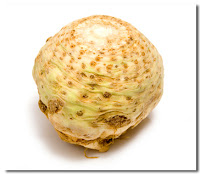- The name is a bit of a give away that it belongs to the same family as celery and has a similar taste.
- It's unusual for a root vegetable, as it has a low starch content. As far as vitamins are concerned, celeriac is a source of Vitamin C and B6.
- You might not immediately think about serving celeriac raw, but you can grate it to add to a salad or coleslaw. More commonly, it's served mashed, either alone or with other root veg, or added to soups or stews.
- I've struggled to find many interesting facts about celeriac, which is a shame. One bit of trivia I did stumble across is that apparently some people drink cocktails through a celeriac stalk, very bizarre!
Oven chips - the celeriac way
- Top and tail the celeriac before removing the skin. Cut the celeriac into thumb-size pieces to give chunky chips - as a general rule a celeriac will serve 2 or 3 people, but obviously depends on the size and how hungry you are!
- Add the celeriac chips to a pan of boiling water and boil for 2-3 mins. Drain, then return to the pan.
- Add 1-2tbsp of vegetable oil to coat (you might be able to get away with less) and add your preferred seasoning - ground black pepper, a tsp of paprika or curry powder would all work well.
- Once on a baking tray, add to a preheated oven (230 degrees C/gas mark 8) and cook for 30-35 mins, giving them a shake once or twice during cooking to ensure they don't stick.
Celeriac and courgette curry - serves 2
Both veg will soak up the spices nicely in this dish.
- Cut a small celeriac into chunks and boil gently for 10 mins, then add a chopped courgette and cook for a further 5 mins.
- Meanwhile chop an onion and cook in a little oil until golden in colour.
- Add a tin of chopped tomatoes to the onions, along with 1tsp each of ground cumin, ground coriander, ground ginger and garam masala.
- Add the drained celeriac and courgette to the pan with the tomato, onion and spices, heating gently for 10 mins.
- Serve with boiled rice or chapatti and a side salad
Perhaps if any of you already use celeriac in your cooking, you might be able to share your favourite celeriac recipe with the rest of us?




